PIONEER DDJ-SB2

INSTALLATION
Firmware & Drivers
Firmware: Update the firmware of the unit to the latest version from http://www.pioneerdj.com/en/support/software/ddj-sb2/#firmware-update
Drivers (for Windows only): Install the latest ASIO drivers from http://www.pioneerdj.com/en/support/software/ddj-sb2/#drivers
No drivers are required for Mac OSX computers
VirtualDJ Setup
Once VirtualDJ is launched, a Login Window will appear to enter your virtualdj.com account credentials.
A Pro Infinity, a Plus or a Pro Subscription License is required to fully use the Pioneer DDJ-SB2 Without any of the above Licenses, the controller will operate for 10 minutes each time you restart VirtualDJ.
https://www.virtualdj.com/buy/index.html

Select “Use Soundcard” in order VirtualDJ to use the pre-defined DDJ-SB2 audio configuration.
Select “Change Skin” to load the Default 4 Decks skin instead of the 2 Decks one.
Click to OK.
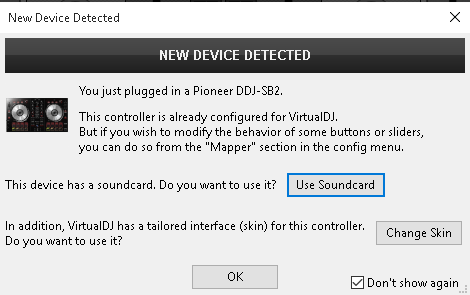
The unit is now ready to operate.
MIDI Operation
Find more details at https://www.virtualdj.com/wiki/VDJ8script.html
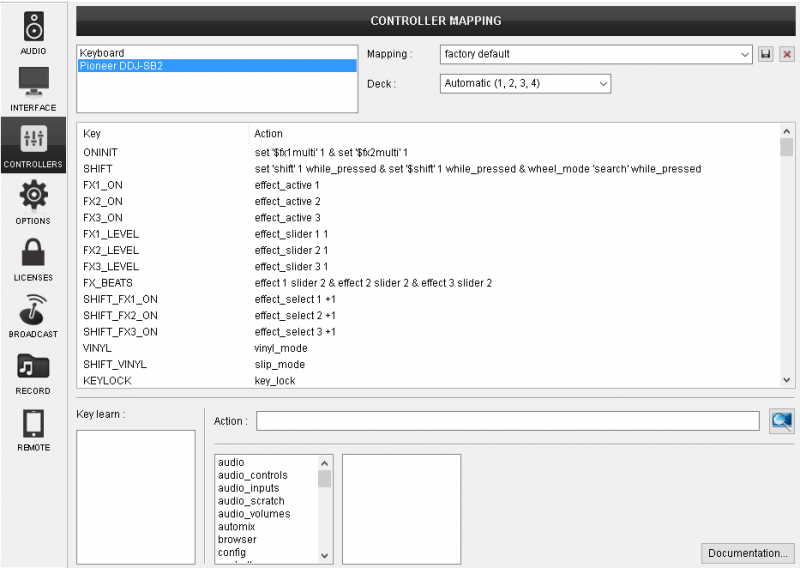
AUDIO Setup
Alternative Audio setups can be applied in the same window.
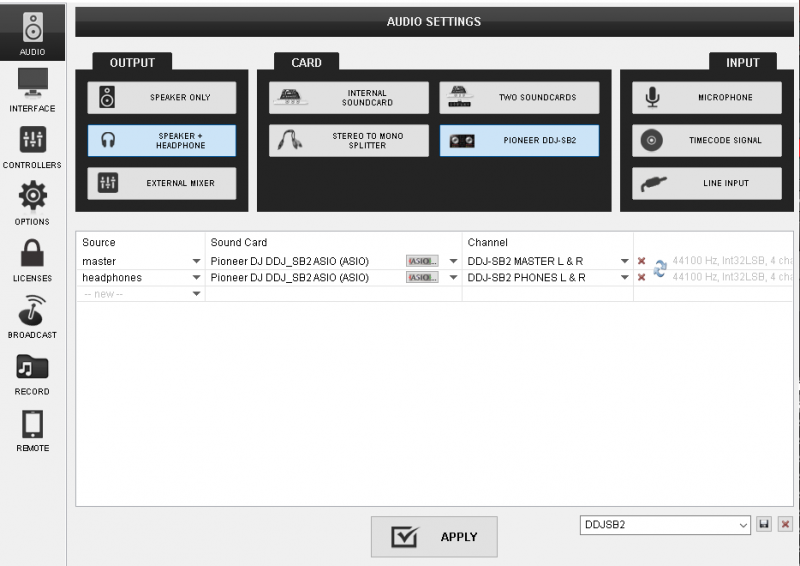
For further software settings please refer to the User Guides of VirtualDJ.
https://www.virtualdj.com/manuals/virtualdj8/index.html
MIXER
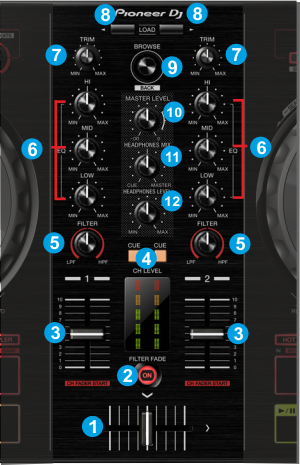
- CROSSFADER: Blends audio (& video if LINK is enabled from the VIDEO panel of VirtualDJ) between the left and the right assigned channels.
- FILTER-FADE ON: If this button is pressed, the crossfader also applies a High Pass filter to the decks.
Read more at the Pioneer DDJ-SB2 product manual). - VOLUME: Channel Volume Faders. Faders alter the sound of the left and right assigned deck. If SHIFT is pressed the Volume Faders will additionally play and sync the track if the fader moves from 0% position and will stop (at the Cue position) the track if the volume reaches 0% position again (Fader Start/Stop).
- CUE: Press this button to send left or/and right channel's pre-fader signal to the Cue Channel for monitoring. When engaged, the button will be lit.
- FILTER: Applies a resonance filter (High Pass/Low Pass) to the left/right track. Middle position is Off position.
- EQ: Adjusts the high (treble) / middle (mid) / low (bass) frequencies of the track.
- TRIM: Adjusts the Gain applied to the left/right assigned Deck. When at middle position, the deck will be output at the defined zero db level (by default 0db).
- LOAD: Use these buttons to load the selected track from the Browser to the left/right assigned VirtualDJ deck.
Hold SHIFT down and then use the same button to unload the same deck. - BROWSE:
Use this knob to scroll through files or folders.
Push the knob to cycle through the available/opened Browser windows (Folders, Songs, Sideview)
If focus is on the Folders list, hold SHIFT down and then push the knob to open/close subfolders.
If focus is on the Songs List, hold SHIFT down and then push the knob to add the selected song to the Automix List.
If focus is on the Sideview, hold SHIFT down and then push the knob to cycle through the available views of Sideview (Automix, Sidelist, Karaoke, Sampler and Shortcuts) - MASTER LEVEL: Adjust the level of the Master Sound Output. The knob is not controlling the Master Output level of the software (hardware operation), thus it will not move the corresponding knob in the VirtualDJ GUI.
- HEADPHONES MIX: Controls the Headphones Mix of VirtualDJ. At left position (0%) the deck(s) will be outputted. At right position (100%) the Master Output will be outputted.
- HEADPHONES LEVEL: Controls the level of the Headphones Sound Output. The knob is not controlling the Headphones Output level of the software (Hardware operation), thus it will not move the corresponding knob in the VirtualDJ GUI.
DECKS
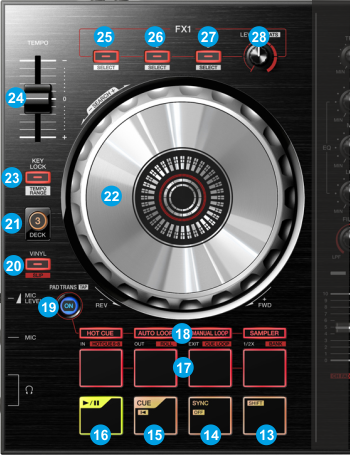
- SHIFT: The SHIFT button if held offers additional functionality to several buttons/knobs.
- SYNC: Syncs the tempo and phase of this deck with the deck that is set as Master (indicated with the M button in the 4 Decks default skin). The Master Deck is automatically by default (auto mode)
Hold SHIFT down and then use this button to manually set a deck as Master.
Once a Deck is manually set as Master, the auto-selection of the Master Deck will not be available. To return to the auto-selection, you will need to press the same button again on the Deck that is currently set as Master. - CUE: If the track is playing, pauses and goes to the last cue point. If the track is paused is paused, sets the current position as cue point, and previews the cue as long as the button is pressed. If SHIFT is pressed, it jumps to the beginning of the track.
- PLAY: Plays-Pauses the track. If SHIFT is pressed it plays the track in Stutter.
- PADS: The 4 PADS offer various actions, depending on the PADMODE selection buttons (18). See PADS for more details.
- PADMODES: Press any of the 4 available buttons to select a mode (HOTCUE, AUTO LOOP, MANUAL LOOP and SAMPLER) for the PADS (17). Press SHIFT and then one of the PADMODE buttons to access the 4 additional modes (HOTCUE 5-8, ROLL, HOTLOOP and SAMPLER BANK) for the PADS (17). The led of each button will flash if any of the 4 additional modes is selected. See the functionality in the PADS Chapter.
- PAD TRANS. Press this button to set the 4 PADS (17) to Trans Mode. See PADS for more details.
- VINYL: Sets the Jog of the deck to Bend (CD) or Scratch (Vinyl) Mode.
Hold SHIFT down and then use this button to enable/disable Slip mode. When Slip mode is enabled, several functions (scratching, HotCues, Loops etc.) will act temporary and the track will resume to the position it would have been if this function was never triggered. - DECK.
Use the left button to assign Deck 1 or Deck 3 as Left selected Deck. When the LED is lit Deck 3 will be controlled by the left side of the DDJ-SB2.
Use the right button to assign Deck 2 or Deck 4 as Right selected Deck. When the LED is lit, Deck 4 will be controlled by the right side of the DDJ-SB2. - JOG: Touch sensitive platter for scratching (vinyl mode) or bending (CD Mode) depending on the VINYL mode (20).
Hold SHIFT and use the JOG in Seek (Search) mode. - KEYLOCK: Press this button to enable/disable the Master Tempo (Key Lock) of the deck.
Hold SHIFT and press this button to cycle through the available Pitch ranges for the PITCH/Tempo Slider. - PITCH: Adjusts the tempo of the track.
- FX ON 1: Press this button to activate the selected effect of slot 1. Hold SHIFT and then press this button to select the next available Effect from the list for Effect slot 1
- FX ON 2: Press this button to activate the selected effect of slot 2. Hold SHIFT and then press this button to select the next available Effect from the list for Effect slot 2
- FX ON 3: Press this button to activate the selected effect of slot 3. Hold SHIFT and then press this button to select the next available Effect from the list for Effect slot 3
- FX LEVEL KNOB: Use this knob to adjust the 1st parameter of the selected effects from all effect slots. Hold SHIFT down and then use this knob to control the 2nd parameter of the selected effects from all effect slots.
PADS
The 4 available PADS offer different functionality depending on the selected mode.
HotCues mode
 Press the HOT CUE mode button to set the PADs to HotCues mode.
Press the HOT CUE mode button to set the PADs to HotCues mode. Each one of the 4 pad assigns a Hot Cue Point (1 to 4) or returns the track to that Hot Cue Point.
When a Hot Cue Button is unlit, you can assign a Hot Cue Point by pressing it at the desired point in your track.
Hold SHIFT and then press a pad to delete its assigned Hot Cue Point. Leds will blink if a HotCue point exists
HotCues 5-8 mode
 Hold SHIFT and then press the press the HOT CUE mode button to set the PADs to HotCues 5-8 mode. The led of the button will blink to indicate this mode
Hold SHIFT and then press the press the HOT CUE mode button to set the PADs to HotCues 5-8 mode. The led of the button will blink to indicate this modeEach one of the 4 pad assigns a Hot Cue Point (5 to 8) or returns the track to that Hot Cue Point.
When a Hot Cue Button is unlit, you can assign a Hot Cue Point by pressing it at the desired point in your track.
Hold SHIFT and then press a pad to delete its assigned Hot Cue Point. Leds will blink if a HotCue point exists
Auto Loop mode
 Press the AUTO LOOP mode button to set the PADs to Auto Loop mode.
Press the AUTO LOOP mode button to set the PADs to Auto Loop mode. Each one of the 4 pad triggers a seamless Loop of a different size (in beats). Hold SHIFT and then press the same Pads to trigger a different loop size (see image)
Roll mode
 Hold SHIFT and then press the AUTO LOOP mode button to set the PADs to Roll mode. The led of the button will blink to indicate this mode
Hold SHIFT and then press the AUTO LOOP mode button to set the PADs to Roll mode. The led of the button will blink to indicate this modeEach one of the 4 pad triggers a momentary (while pressed) Loop Roll of a different size (in beats). Hold SHIFT and then press the same Pads to trigger a different size of loop roll (see image)
Manual Loop mode
 Press the MANUAL LOOP mode button to set the PADs to Manual Loop mode.
Press the MANUAL LOOP mode button to set the PADs to Manual Loop mode. Use the 1st PAD to set a Loop In (Entry) point. Use the 2nd PAD to set the Exit point of the loop (Loop Out). Use the 3rd PAD to exit the Loop. Use the 4rt PAD to half the size of the Loop.
While SHIFT is held, use the 1st and 2nd PADs to move the triggered loop 1 beat backwards or forward. Use the 3rd PAD to activate the last triggered loop (Reloop) and the 4rth PAD to double the size of the Loop.
HotCues - Loop mode
 Hold SHIFT and then press the MANUAL LOOP button to set the PADs to HotCues Loop mode. The led of the button will blink to indicate this mode.
Hold SHIFT and then press the MANUAL LOOP button to set the PADs to HotCues Loop mode. The led of the button will blink to indicate this mode.Each one of the 4 pad assigns a Hot Cue Point (1 to 4) or returns the track to that Hot Cue Point, but in both cases, it also triggers a Loop at that point, while the Pad is pressed. Hold SHIFT and then use the same PADs to apply the same functionality for HotCues 5 to 8.
Sampler mode
 Press the SAMPLER mode button to set the PADs to Sampler mode.
Press the SAMPLER mode button to set the PADs to Sampler mode.Each one of the 4 pads triggers a sample from the selected Sampler Bank of VirtualDJ. If a bank has less than 5 samples, both sides of the DDJ-SB will control the same samples. If a bank has more than 4 samples, the left side of the DDJ-SB will control samples 1 to 4 and the right side samples 5 to 8
Depending on the selected trigger mode, use SHIFT and the same pads to stop the sample.
Sampler Bank mode
 Hold SHIFT and then press the SAMPLER mode button to set the PADs to Sampler Bank mode. The led of the button will blink to indicate this mode.
Hold SHIFT and then press the SAMPLER mode button to set the PADs to Sampler Bank mode. The led of the button will blink to indicate this mode.Use these PADs to select the first 4 Banks* of the VirtualDJ Sampler.
Hold SHIFT and then use the same PADs to select the Trigger Mode of the Samples.
*.VirtualDJ offers unlimited Banks, which can be accessed through the GUI of VirtualDJ
PAD TRANS mode
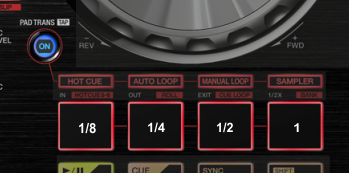 Press the PAD TRANS mode button to set the PADs to Pad Trans mode. The led of the button will blink to indicate this mode.
Press the PAD TRANS mode button to set the PADs to Pad Trans mode. The led of the button will blink to indicate this mode.Use these PADs to apply a “Cut” Effect on the deck. While a PAD is pressed, the Volume of the Deck will be toggling between the zero and the current position at a frequency defined by the size in beats as per the image.
